EHS培训矩阵
- 格式:xlsx
- 大小:24.63 KB
- 文档页数:4
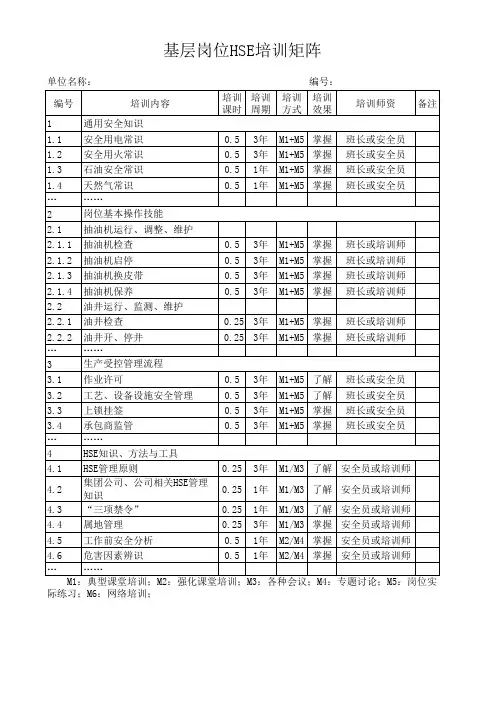
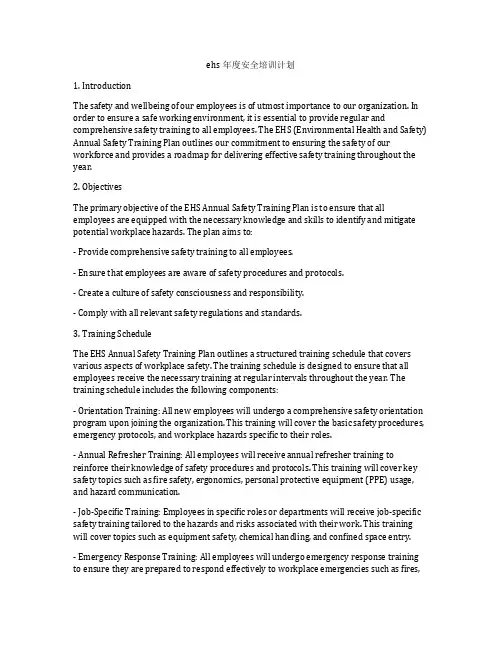
ehs年度安全培训计划1. IntroductionThe safety and wellbeing of our employees is of utmost importance to our organization. In order to ensure a safe working environment, it is essential to provide regular and comprehensive safety training to all employees. The EHS (Environmental Health and Safety) Annual Safety Training Plan outlines our commitment to ensuring the safety of our workforce and provides a roadmap for delivering effective safety training throughout the year.2. ObjectivesThe primary objective of the EHS Annual Safety Training Plan is to ensure that all employees are equipped with the necessary knowledge and skills to identify and mitigate potential workplace hazards. The plan aims to:- Provide comprehensive safety training to all employees.- Ensure that employees are aware of safety procedures and protocols.- Create a culture of safety consciousness and responsibility.- Comply with all relevant safety regulations and standards.3. Training ScheduleThe EHS Annual Safety Training Plan outlines a structured training schedule that covers various aspects of workplace safety. The training schedule is designed to ensure that all employees receive the necessary training at regular intervals throughout the year. The training schedule includes the following components:- Orientation Training: All new employees will undergo a comprehensive safety orientation program upon joining the organization. This training will cover the basic safety procedures, emergency protocols, and workplace hazards specific to their roles.- Annual Refresher Training: All employees will receive annual refresher training to reinforce their knowledge of safety procedures and protocols. This training will cover key safety topics such as fire safety, ergonomics, personal protective equipment (PPE) usage, and hazard communication.- Job-Specific Training: Employees in specific roles or departments will receive job-specific safety training tailored to the hazards and risks associated with their work. This training will cover topics such as equipment safety, chemical handling, and confined space entry.- Emergency Response Training: All employees will undergo emergency response training to ensure they are prepared to respond effectively to workplace emergencies such as fires,spills, and medical incidents. This training will include evacuation procedures, first aid/CPR training, and the use of emergency equipment.- Regulatory Compliance Training: Employees will receive training on relevant safety regulations and standards to ensure compliance with OSHA (Occupational Safety and Health Administration) and other regulatory bodies. This training will cover topics such as recordkeeping, hazard communication, and safety management systems.4. Training Delivery MethodsThe EHS Annual Safety Training Plan utilizes a variety of training delivery methods to ensure that employees receive effective and engaging safety training. The training delivery methods include:- Classroom Training: In-person classroom training sessions will be conducted for certain topics that require hands-on demonstrations or interactive learning activities. These sessions will be led by experienced safety trainers and will provide an opportunity for employees to ask questions and engage in discussions.- Online Training: E-learning modules and online training courses will be made available to employees for topics that can be effectively delivered in a self-paced, digital format. These online courses will cover a wide range of safety topics and will be accessible to employees at their convenience.- Hands-On Training: Certain safety topics, such as equipment safety and emergency response, will require hands-on training to ensure that employees are competent in applying their knowledge in real-world scenarios. Hands-on training sessions will be conducted in controlled environments to provide employees with practical experience.- Safety Drills and Simulations: Regular safety drills and simulations will be conducted to test employees' knowledge and response to various workplace emergencies. These drills will be designed to mimic real-life situations and will provide employees with the opportunity to practice their emergency response skills.5. Evaluation and FeedbackThe EHS Annual Safety Training Plan includes a robust evaluation and feedback system to measure the effectiveness of the training and gather input from employees. The evaluation and feedback process includes the following components:- Pre- and Post-Training Assessments: Employees will undergo pre-training assessments to gauge their existing knowledge and skills related to the training topic. Post-training assessments will be conducted to measure the impact of the training and identify areas for improvement.- Training Effectiveness Surveys: Employees will be provided with training effectiveness surveys to gather feedback on the quality of training, training materials, and trainer effectiveness. This feedback will be used to continuously improve the training program.- Incident Analysis: Incidents and near-misses will be analyzed to identify any gaps in the training program and to determine if additional training is required to prevent similar incidents in the future.- Continuous Improvement: The evaluation and feedback gathered from employees will be used to continuously improve the EHS Annual Safety Training Plan. This includes updating training materials, modifying training delivery methods, and incorporating new safety topics based on employee feedback.6. Compliance and ReportingThe EHS Annual Safety Training Plan is designed to ensure compliance with all relevant safety regulations and standards. Training records will be maintained to demonstrate that employees have received the required safety training. The EHS team will regularly review and audit training records to ensure that all employees are up to date with their safety training. In addition, regular reporting on training completion rates, evaluation results, and incident analysis will be provided to the management team to ensure transparency and accountability.7. ConclusionThe EHS Annual Safety Training Plan outlines our commitment to providing comprehensive safety training to all employees. By implementing a structured training schedule, utilizing a variety of training delivery methods, and continuously evaluating and improving the training program, we aim to create a culture of safety awareness and responsibility within our organization. Through regular safety training, we will equip our employees with the knowledge and skills necessary to identify and mitigate workplace hazards, ultimately creating a safe and healthy work environment for all.。
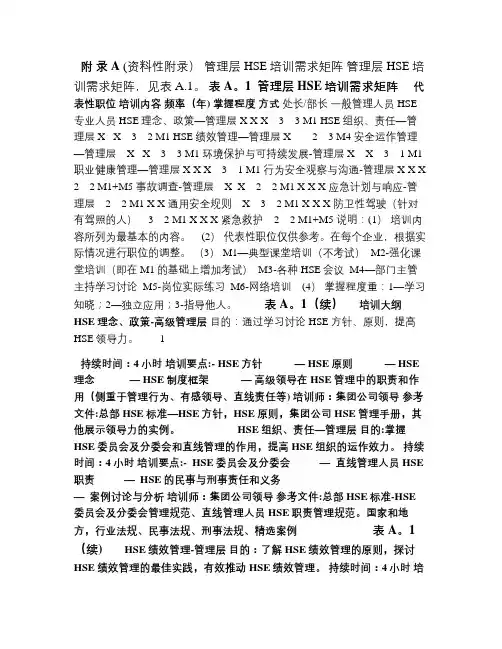
附录 A (资料性附录)管理层HSE培训需求矩阵管理层HSE培训需求矩阵,见表A.1。
表 A。
1 管理层HSE培训需求矩阵代表性职位培训内容频率(年) 掌握程度方式处长/部长一般管理人员 HSE专业人员 HSE理念、政策—管理层 X X X 3 3 M1 HSE组织、责任—管理层 X X 3 2 M1 HSE绩效管理—管理层 X 2 3 M4 安全运作管理—管理层 X X 3 3 M1 环境保护与可持续发展-管理层 X X 3 1 M1 职业健康管理—管理层 X X X 3 1 M1 行为安全观察与沟通-管理层 X X X 2 2 M1+M5 事故调查-管理层 X X 2 2 M1 X X X 应急计划与响应-管理层 2 2 M1 X X 通用安全规则 X 3 2 M1 X X X 防卫性驾驶(针对有驾照的人) 3 2 M1 X X X 紧急救护 2 2 M1+M5 说明:(1)培训内容所列为最基本的内容。
(2)代表性职位仅供参考。
在每个企业,根据实际情况进行职位的调整。
(3) M1—典型课堂培训(不考试) M2-强化课堂培训(即在M1的基础上增加考试) M3-各种HSE会议 M4—部门主管主持学习讨论 M5-岗位实际练习 M6-网络培训 (4)掌握程度重:1—学习知晓;2—独立应用;3-指导他人。
表A。
1(续)培训大纲HSE理念、政策-高级管理层目的:通过学习讨论HSE方针、原则,提高HSE领导力。
1持续时间:4小时培训要点:- HSE方针— HSE原则— HSE理念— HSE制度框架—高级领导在HSE管理中的职责和作用(侧重于管理行为、有感领导、直线责任等) 培训师:集团公司领导参考文件:总部HSE标准—HSE方针,HSE原则,集团公司HSE管理手册,其他展示领导力的实例。
HSE组织、责任—管理层目的:掌握HSE委员会及分委会和直线管理的作用,提高HSE组织的运作效力。
持续时间:4小时培训要点:- HSE委员会及分委会—直线管理人员HSE职责— HSE的民事与刑事责任和义务—案例讨论与分析培训师:集团公司领导参考文件:总部HSE标准-HSE委员会及分委会管理规范、直线管理人员HSE职责管理规范。
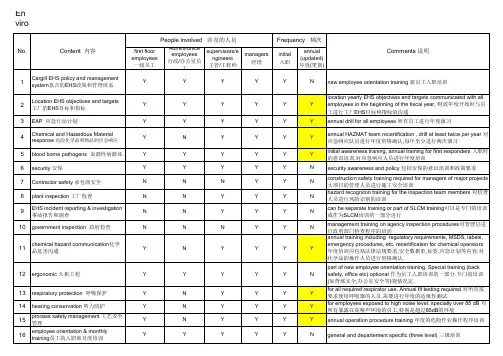
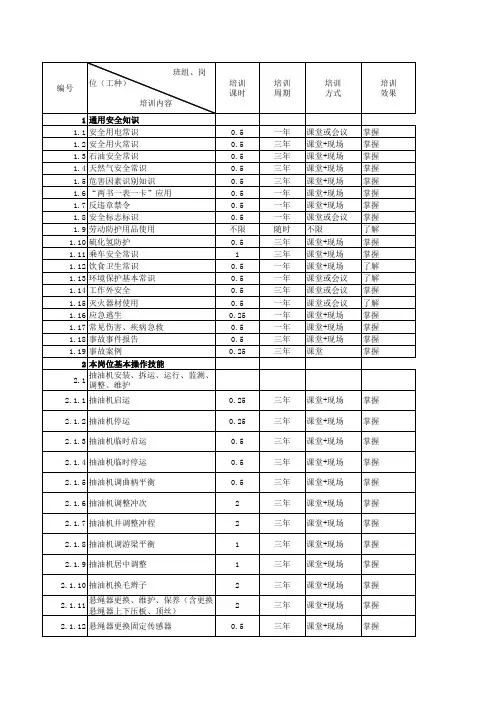
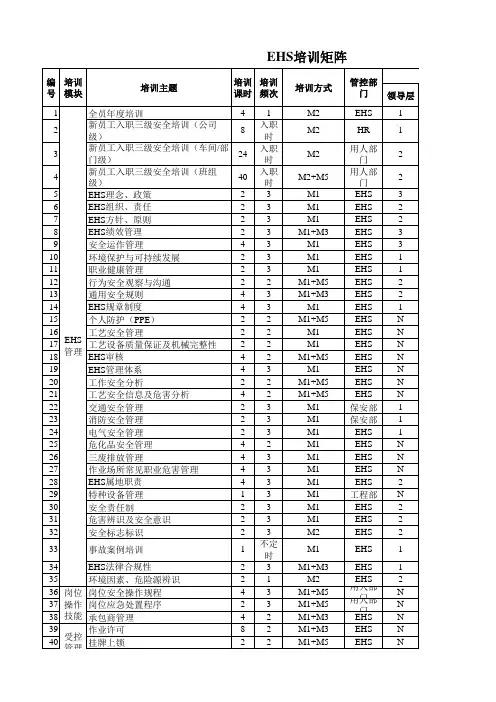
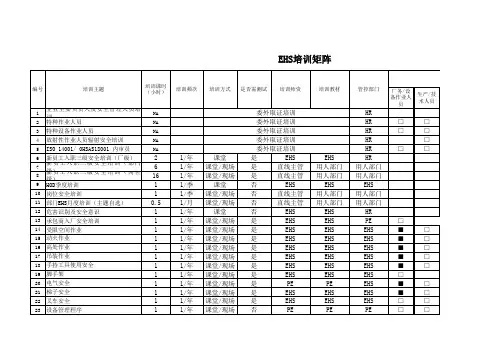
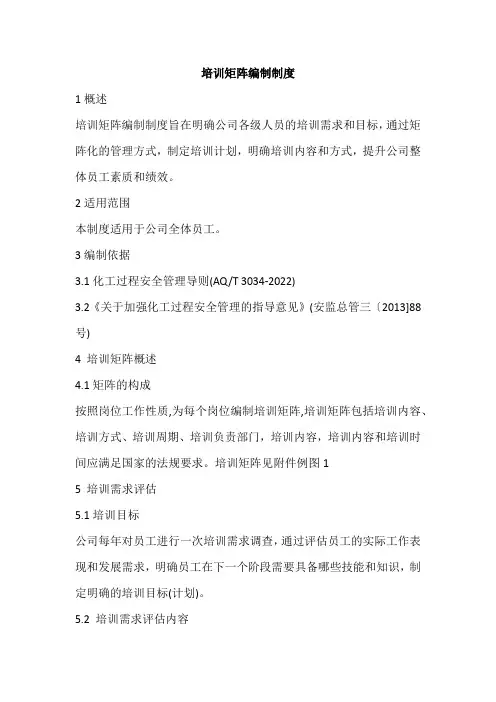
培训矩阵编制制度1概述培训矩阵编制制度旨在明确公司各级人员的培训需求和目标,通过矩阵化的管理方式,制定培训计划,明确培训内容和方式,提升公司整体员工素质和绩效。
2适用范围本制度适用于公司全体员工。
3编制依据3.1化工过程安全管理导则(AQ/T 3034-2022)3.2《关于加强化工过程安全管理的指导意见》(安监总管三〔2013]88号)4 培训矩阵概述4.1矩阵的构成按照岗位工作性质,为每个岗位编制培训矩阵,培训矩阵包括培训内容、培训方式、培训周期、培训负责部门,培训内容,培训内容和培训时间应满足国家的法规要求。
培训矩阵见附件例图15 培训需求评估5.1培训目标公司每年对员工进行一次培训需求调查,通过评估员工的实际工作表现和发展需求,明确员工在下一个阶段需要具备哪些技能和知识,制定明确的培训目标(计划)。
5.2 培训需求评估内容5.2.1评估员工目前的岗位职责和表现,确定是否需要培训以进一步提高业务能力。
5.2.2评估员工未来的职业发展方向和需求,确定需要掌握哪些固定技能和未来需求的技能。
5.2.3根据员工的绩效评估结果、培训需求反馈等综合指标,确定培训需求。
6培训计划制定6.1培训计划的目标制定培训计划,旨在提高员工业务能力和创新能力,完善员工考核系统,提升公司整体竞争力。
6.2培训计划的内容6.2.1制定培训的时限、内容、形式、目标等方面的明确规定。
6.2.2围绕公司的业务发展和员工的实际情况,制定符合实际、可操作、落地有效的培训计划。
6.2.3根据员工的职业轨迹和发展方向,分层次制定相应培训计划。
6.2.4制定明确的培训考核标准,每半年对教育培训的执行情况进行考核,确保培训计划的有效性。
7 培训方式的选择7.1内部培训内部员工进行技能培训、安全知识分享等活动。
7.2外部培训邀请专家或参加行业领袖、政府组织的课程和活动,如大型研讨会、学习培训、演讲活动等。
7.3自我学习鼓励员工通过网上课程、学习心得分享等形式进行自我学习和提升。
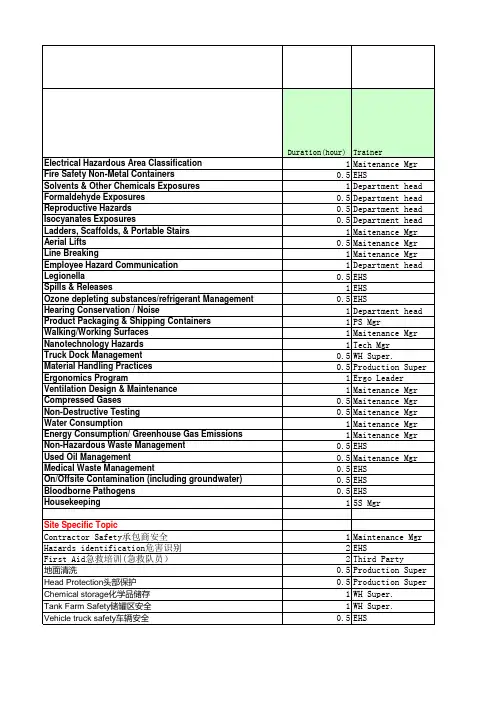
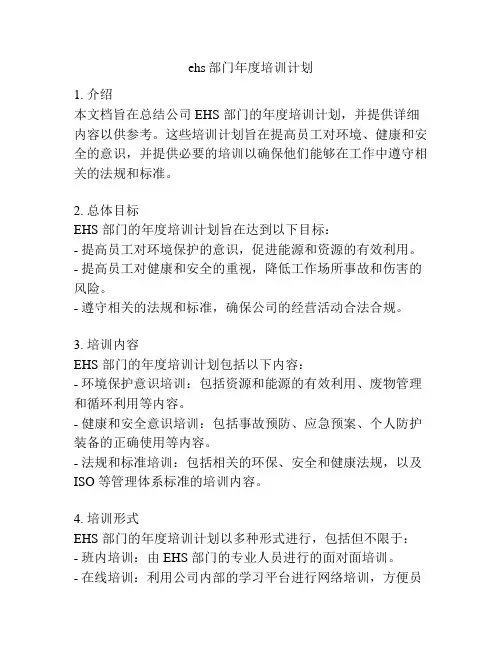
ehs部门年度培训计划
1. 介绍
本文档旨在总结公司 EHS 部门的年度培训计划,并提供详细内容以供参考。
这些培训计划旨在提高员工对环境、健康和安全的意识,并提供必要的培训以确保他们能够在工作中遵守相关的法规和标准。
2. 总体目标
EHS 部门的年度培训计划旨在达到以下目标:
- 提高员工对环境保护的意识,促进能源和资源的有效利用。
- 提高员工对健康和安全的重视,降低工作场所事故和伤害的风险。
- 遵守相关的法规和标准,确保公司的经营活动合法合规。
3. 培训内容
EHS 部门的年度培训计划包括以下内容:
- 环境保护意识培训:包括资源和能源的有效利用、废物管理和循环利用等内容。
- 健康和安全意识培训:包括事故预防、应急预案、个人防护装备的正确使用等内容。
- 法规和标准培训:包括相关的环保、安全和健康法规,以及ISO 等管理体系标准的培训内容。
4. 培训形式
EHS 部门的年度培训计划以多种形式进行,包括但不限于:- 班内培训:由 EHS 部门的专业人员进行的面对面培训。
- 在线培训:利用公司内部的学习平台进行网络培训,方便员
工随时随地进行学习。
- 外部培训:组织员工参加相关领域的外部培训课程,以提高培训效果。
5. 培训计划
EHS 部门的年度培训计划将根据具体情况制定详细的时间表和内容安排,确保全面覆盖相关内容,并保证每位员工都能够参与到相应的培训中。
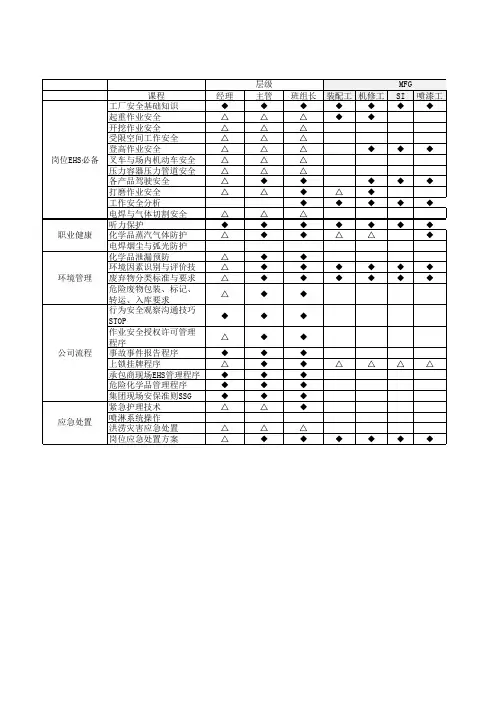
EHS培训管理制度1.目的为了符合法规要求,使本公司的所有人员能及时了解公司的EHS规定,全面实施EHS培训计划,确保所有人员均可及时得到所需的EHS培训,满足当地法律法规和公司的EHS管理标准的要求。
2.范围本制度适用本公司的所有人员。
3.三级安全教育EHS三级教育是公司EHS教育的基本教育。
教育对象是新进厂或新就职的人员,具体指厂级、车间级和班组级EHS教育。
三级教育培训内容如下:3.1.厂级EHS教育培训内容1) 公司基本概况(总图及平面布置、加工产品、生产规模、工艺流程);2) 公司EHS方针和EHS管理体系要求;3) 国家有关EHS法律法规;4) 公司EHS管理制度;5) 公司重大环境因素、危害因素的识别和防范措施;6) EHS基本知识(安全色与安全标志、污水处理、危险废物管理、危险化学品、电气安全、机械防护、特种设备、作业许可、个人防护用品、事故调查报告、职业卫生);7) 消防系统的构成、灭火方法和器材的使用;8) 应急疏散计划(火灾、泄漏、恶劣天气);9) 有关事故案例等;3.2.车间级EHS教育培训内容1) 车间概况(生产产品、生产特点、安全职责);2) 工作环境及危险有害因素;3) 环境污染、工伤事故及职业危害的预防措施;4) 现场紧急情况的处理;5) 应急疏散;6) 事故伤害急救;7) 现场保护;8) 事故报告;9) 车间EHS管理制度;10) 环保、安全、职业危害防护、消防设备设施的分布、使用和维护;11) 个人防护用品(PPE)的使用和维护;12) 车间常见和典型事故案例;3.3.班组级EHS教育培训内容1) 岗位安全操作规程和实际安全操作示范;2) 所从事工种可能遭受的职业伤害和预防措施;3) 岗位之间工作衔接配合的安全注意事项;4) 本岗位常见和典型事故案例;(注岗位安全注意事项可做成卡片,张贴在工作场所醒目位置);4.工作内容员工EHS培训及EHS能力提升的责任人是其直线领导:单位各部门员工的培训负责人是该部门经理;部门主管对其管辖范围内的一线员工的培训负责;EHS 部与人事部为各部门提供EHS培训支持。
企业ehs年度培训计划方案
一、培训内容和目标:
1. 安全管理制度和操作规程的培训,提高员工对安全管理制度和操作规程的理解和遵守意识,降低事故风险。
2. 环境保护法律法规和企业环境保护政策的培训,促使员工遵守相关法规,保护环境,减少对环境的不良影响。
3. 应急预案和逃生逃生演练的培训,提高员工灾难应急处置和自救互救能力。
4. 职业健康知识的培训,让员工了解职业病危害和防护措施,提高自我保护意识。
二、培训形式和时间:
1. 内部专家辅导培训,每月组织一次,培训时间为2小时。
2. 外部培训讲座,每季度邀请专家进行一次,培训时间为4小时。
三、培训实施方法:
1. 制定年度培训计划,明确每次培训内容、目标和形式。
2. 通过内部通知和外部邀请函向员工宣传培训内容和时间。
3. 培训结束后,开展培训效果评估,及时调整和改进培训计划。
四、培训效果评估:
1. 培训后随机抽查员工对培训内容的掌握情况,并进行考核。
2. 根据员工对培训的反馈意见,对培训内容和形式进行改进和升级。
五、培训资源保障:
1. 提供培训场所和设备。
2. 培训材料的准备和发放。
3. 每次培训的组织和协调。
六、培训计划落实情况的监督和考核:
1. 对每次培训的实施情况进行跟踪和考核。
2. 对培训计划的有效性进行总结和评估。
ehs部门级培训计划本文将围绕EHS部门级培训计划展开讨论,从培训目标、培训内容、培训形式以及培训评估等方面进行详细阐述。
一、培训目标1. 提高员工的EHS意识。
通过培训,让员工了解EHS的重要性,增强对环境、健康与安全的关注和责任感,形成良好的EHS意识。
2. 掌握相关法律法规和政策。
培训员工了解国家、地方法律法规和企业相关政策,确保EHS部门的工作符合法律法规。
3. 掌握EHS管理知识和技能。
培训员工掌握EHS管理知识和技能,提高EHS管理水平,保障员工的健康和安全,保护环境。
4. 培养团队合作意识。
通过培训,促进EHS部门的团队合作,提高工作效率,确保EHS 工作的顺利开展。
二、培训内容1. EHS基本概念。
介绍EHS的基本概念、意义和目标,引导员工对EHS的重要性有清晰的认知。
2. 相关法律法规和政策。
介绍国家、地方法律法规和企业相关政策,强调EHS的合规性和重要性。
3. 工作场所安全。
介绍工作场所的安全措施和操作规程,包括事故预防、紧急救护等。
4. 环境保护意识。
培养员工的环保意识,强调减少污染、节约资源等环保行为。
5. 健康管理。
介绍健康管理知识,包括心理健康、体检、饮食、运动等方面的健康知识。
6. 应急管理。
介绍应急情况处理流程和方法,包括火灾、事故、自然灾害等应急情况的处理方法。
三、培训形式1. 理论培训。
采用讲座、课堂教学等形式进行理论培训,由EHS部门负责人或专家讲解EHS理论知识和工作流程。
2. 案例分享。
邀请有经验的员工分享EHS相关的案例,让员工通过实际案例了解EHS工作中可能遇到的问题和解决方法。
3. 视频培训。
利用企业内部资源或外部培训资源,制作EHS相关的培训视频,让员工通过视频了解EHS知识和技能。
4. 现场演练。
组织现场演练,让员工参与实际操作,提高员工对EHS工作的实际操作能力。
5. 网络培训。
利用企业内部网络或互联网资源,进行在线培训,让员工通过网络学习EHS知识。